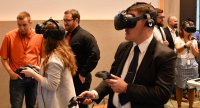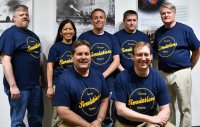By John Joyce, NSWC Dahlgren Division Corporate Communications



KING GEORGE, Va. - Navy scientists and engineers briefed more than 400 visitors on a myriad of technological projects at the first Modeling and Simulation Summit sponsored by the Naval Surface Warfare Center Dahlgren Division (NSWCDD), May 22.
The annual event - held at the University of Mary Washington Dahlgren campus - focused on modeling and simulation capabilities in areas such as model-based systems engineering, mission engineering and analysis, theater and force level modeling, computational physics, optimization, virtual reality and 3D scanning.
"Modeling and simulation touches nearly every aspect of work conducted at NSWC Dahlgren from the development of the most basic component to the functionality and interoperability of integrated battlespaces," said Angela Beach, NSWCDD deputy technical director who welcomed attendees. "There is similar M&S work being conducted in different departments across NSWCDD and NAVSEA (Naval Sea Systems Command). As a result, collaboration and networking facilitates an opportunity to learn from others and improve overall capability."
Technologists from the NAVSEA Warfare Centers, Missile Defense Agency, Johns Hopkins University Applied Physics Laboratory, Joint Warfare Analysis Center, and the Navy Modeling and Simulation Office joined their NSWCDD counterparts to collaborate and network while learning how new and emerging modeling and simulation capabilities can impact their technical programs.
In her keynote speech, Amy Markowich described how her role as the Department of the Navy Modeling and Simulation executive has changed from its initial emphasis to convince sponsors that modeling and simulation is a valuable capability for the Navy's technical programs. Markowich - who is also the Integrated Battlespace Simulation and Test Department director at Naval Air Systems Command - told the packed house her efforts now focus on ensuring everyone who works on modeling and simulation or benefits from the technology has the connections they need to optimize their impact.
"The first M&S Summit was wildly successful in achieving our goals of showcasing the great work done by analysts here at Dahlgren and facilitating collaboration both internally and externally," said John Romano, Advanced Modeling and Simulation Group lead at the NSWCDD System Control and Integration Branch. "In the days following the event, I have heard from several groups that cultivated new working relationships as a direct result of this event."
The summit - established to highlight NSWCDD modeling and simulation capabilities while encouraging networking and collaboration both internally and externally - is comprised of professionals from the command's modeling and simulation community.
"One of the greatest indicators of success is that I consistently hear how people learned about modeling and simulation capabilities they didn't know we had at Dahlgren and that they made connections that will be helpful for their projects," said Sam Koski, NSWCDD Warfare Analysis and Digital Modeling Department's digital engineering lead who organized the event with Romano and seven other steering committee members.
In all, NSWCDD scientists and engineers showcased their modeling and simulation capabilities via four demonstrations and 36 posters on projects ranging from Longbow Hellfire Thermal Testing and Analysis to Exterior Aerodynamics - Computational Fluid Dynamics.
"Several of the presentations given at the modeling and simulation event included analyses performed for our program," said Julien Weckering, Blast Assisting Munitions (BAM) team member, regarding BAM concept development work performed at the NSWCDD Guns, Ammunition, and Expeditionary Weapons Branch. "It was beneficial to be able to gather and interact with some of the groups we work with all in one place. Perhaps more importantly, it provided an opportunity to network with on-base experts I was previously unaware of that had ready answers and analytical techniques to address problems our program will need to work through in the near future."
The success of the BAM effort - part of an Office of Naval Research Future Naval Capabilities program - hinges on collaboration between NSWCDD, NSWC Indian Head Explosive Ordnance Disposal Technology Division, Naval Postgraduate School, and industry partners.
"The modeling and simulation event provided an opportunity for the BAM team to socialize our capabilities and to further our collaboration within the NSWCDD community," said Stephen Dix, BAM Design Development lead.
Meanwhile at the event, engineers from the Dahlgren's Digital Engineering Ship Integration Lab (DESIL) discovered that their 3D scans, models, and future modeling products could positively affect simulation and analysis programs throughout the Navy.
DESIL's ability to leverage emerging technologies and digital engineering strategies increases the efficiency of below-decks combat system ship checks, enables more detailed drawing packages, and supports Navy-wide efforts to decrease costs, increases efficiencies, and assists in delivering ships to the fleet on-time.
"It was an excellent opportunity for our lab to network with other modeling efforts around the base, as well as present to the community the work we're doing in a forum that fosters and encourages collaboration," said Michael Darnell, DESIL lead. "Our lab is currently looking at developing 3D models of combat system spaces. We were able to talk with several teams to understand how other groups may be able to utilize scans and models developed within our branch for uses that we hadn't even thought of - such as gas simulation and damage analysis. This understanding of how our future modeling products could be utilized helps us make small changes during product development to enable optimal use by simulation and analysis teams around the Navy. In today's ever-changing environment, it's critical that a focus is put on collaboration and innovation in everything we do. The M&S Summit was representative of both of those principles."



KING GEORGE, Va. - Navy scientists and engineers briefed more than 400 visitors on a myriad of technological projects at the first Modeling and Simulation Summit sponsored by the Naval Surface Warfare Center Dahlgren Division (NSWCDD), May 22.
The annual event - held at the University of Mary Washington Dahlgren campus - focused on modeling and simulation capabilities in areas such as model-based systems engineering, mission engineering and analysis, theater and force level modeling, computational physics, optimization, virtual reality and 3D scanning.
"Modeling and simulation touches nearly every aspect of work conducted at NSWC Dahlgren from the development of the most basic component to the functionality and interoperability of integrated battlespaces," said Angela Beach, NSWCDD deputy technical director who welcomed attendees. "There is similar M&S work being conducted in different departments across NSWCDD and NAVSEA (Naval Sea Systems Command). As a result, collaboration and networking facilitates an opportunity to learn from others and improve overall capability."
Technologists from the NAVSEA Warfare Centers, Missile Defense Agency, Johns Hopkins University Applied Physics Laboratory, Joint Warfare Analysis Center, and the Navy Modeling and Simulation Office joined their NSWCDD counterparts to collaborate and network while learning how new and emerging modeling and simulation capabilities can impact their technical programs.
In her keynote speech, Amy Markowich described how her role as the Department of the Navy Modeling and Simulation executive has changed from its initial emphasis to convince sponsors that modeling and simulation is a valuable capability for the Navy's technical programs. Markowich - who is also the Integrated Battlespace Simulation and Test Department director at Naval Air Systems Command - told the packed house her efforts now focus on ensuring everyone who works on modeling and simulation or benefits from the technology has the connections they need to optimize their impact.
"The first M&S Summit was wildly successful in achieving our goals of showcasing the great work done by analysts here at Dahlgren and facilitating collaboration both internally and externally," said John Romano, Advanced Modeling and Simulation Group lead at the NSWCDD System Control and Integration Branch. "In the days following the event, I have heard from several groups that cultivated new working relationships as a direct result of this event."
The summit - established to highlight NSWCDD modeling and simulation capabilities while encouraging networking and collaboration both internally and externally - is comprised of professionals from the command's modeling and simulation community.
"One of the greatest indicators of success is that I consistently hear how people learned about modeling and simulation capabilities they didn't know we had at Dahlgren and that they made connections that will be helpful for their projects," said Sam Koski, NSWCDD Warfare Analysis and Digital Modeling Department's digital engineering lead who organized the event with Romano and seven other steering committee members.
In all, NSWCDD scientists and engineers showcased their modeling and simulation capabilities via four demonstrations and 36 posters on projects ranging from Longbow Hellfire Thermal Testing and Analysis to Exterior Aerodynamics - Computational Fluid Dynamics.
"Several of the presentations given at the modeling and simulation event included analyses performed for our program," said Julien Weckering, Blast Assisting Munitions (BAM) team member, regarding BAM concept development work performed at the NSWCDD Guns, Ammunition, and Expeditionary Weapons Branch. "It was beneficial to be able to gather and interact with some of the groups we work with all in one place. Perhaps more importantly, it provided an opportunity to network with on-base experts I was previously unaware of that had ready answers and analytical techniques to address problems our program will need to work through in the near future."
The success of the BAM effort - part of an Office of Naval Research Future Naval Capabilities program - hinges on collaboration between NSWCDD, NSWC Indian Head Explosive Ordnance Disposal Technology Division, Naval Postgraduate School, and industry partners.
"The modeling and simulation event provided an opportunity for the BAM team to socialize our capabilities and to further our collaboration within the NSWCDD community," said Stephen Dix, BAM Design Development lead.
Meanwhile at the event, engineers from the Dahlgren's Digital Engineering Ship Integration Lab (DESIL) discovered that their 3D scans, models, and future modeling products could positively affect simulation and analysis programs throughout the Navy.
DESIL's ability to leverage emerging technologies and digital engineering strategies increases the efficiency of below-decks combat system ship checks, enables more detailed drawing packages, and supports Navy-wide efforts to decrease costs, increases efficiencies, and assists in delivering ships to the fleet on-time.
"It was an excellent opportunity for our lab to network with other modeling efforts around the base, as well as present to the community the work we're doing in a forum that fosters and encourages collaboration," said Michael Darnell, DESIL lead. "Our lab is currently looking at developing 3D models of combat system spaces. We were able to talk with several teams to understand how other groups may be able to utilize scans and models developed within our branch for uses that we hadn't even thought of - such as gas simulation and damage analysis. This understanding of how our future modeling products could be utilized helps us make small changes during product development to enable optimal use by simulation and analysis teams around the Navy. In today's ever-changing environment, it's critical that a focus is put on collaboration and innovation in everything we do. The M&S Summit was representative of both of those principles."
